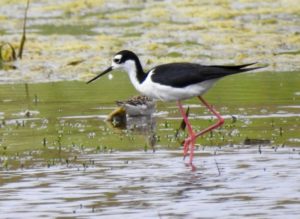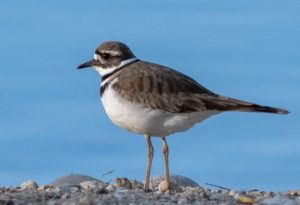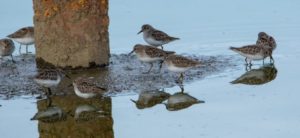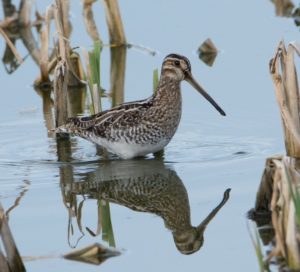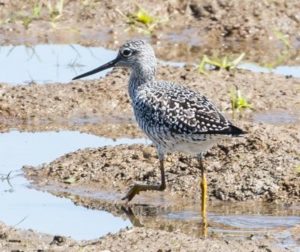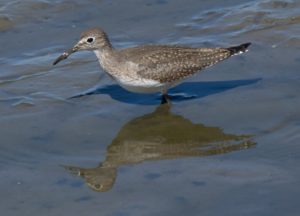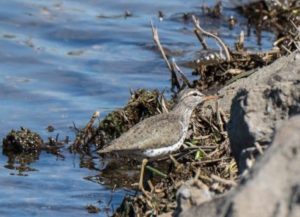Text and photos by Louisa Evers except as noted.
Please see Birding for Citizen Science in Middleton River Park, and Songbirds of the Boise River Part 1, Part 2 and Part 3 for introductory information, directions and lots of song birds. Bird safely.
In this blog I will introduce you to some of the birds that people typically hunt (game birds) and birds that wade in water. Birds that typically walk in the water or on the shore belong to more than one bird family, so I am using “wading birds” as a generic term for them. Migration is nearly done, so the birds found now should mostly be summer birds and year-round residents. That said, there’s always the possibility of a late migrating bird.
Upland Game Birds
Upland game birds are typically chicken-like, ground-dwelling birds that feed on seeds, bugs, and other plant parts as well as some insects. They are usually quite secretive, largely because they are hunted. They are found in pairs in spring and in groups at other times of the year. Flocks of game birds are called coveys. Often you discover them when they flush with an explosive flight. Their wings are rounded and their wingbeats are rapid and stiff. They rarely fly very far and may run away from you or your dog, if they think its possible. Their young are born with down, open eyes and they are able to walk as soon as they dry out. Young game birds develop quickly and some have functional flight feathers when only a week old. Three species of upland game birds have been found in the park area.
California quail – California quail are the most common game bird in the park area, forming large coveys in winter. They are most common where brush is the thickest and under wide-crowned trees with abundant low branches, such as Russian olive. You can see them on the trails, particularly when they are picking up grit for their crops and grass seeds. They are easily recognized by their forward-facing topknot, with the male’s topknot much larger and more noticeable than the female’s topknot. Overall, California quail are gray. Males have a black face and neck with a white stripe along the side, a white stripe running mostly around the crown, a reddish crown, and scaled appearance to the belly. Females lack the black and white marks in the face. Male birds “sing” from exposed low perches, such as fence posts and low branches; the “song” is a simple caaw. Quail also cluck and sputter and are best known for a call that sounds like Chi-CA-go, Chi-CA-go! You are likely to hear more quail than you see
Ring-necked pheasant – Ring-necked pheasants were introduced from Asia but have naturalized through much of North America. In the park, pheasants also tend to hang around denser brush and tree areas but can also be seen in more open areas with cover nearby. Pheasants have long, pointed tails, with the female’s tail shorter than the male’s tail. Overall males are a more rusty color while females are a mottled brown. Males also have a red face, blue neck, and white ring at the base of the neck. In spring, you can hear the males crow a harsh UURK-iilk, but otherwise these birds are mostly silent. Most of the year you will know there are pheasants when they flush. Look for that long tail to identify a flushing pheasant.
Wild turkey – Turkeys are an introduced large bird most likely seen in fall as they feed in farm fields, but you can encounter them in the park area. Most often birders have seen them in the vicinity of the marshy areas. Overall, turkeys are dark green, although the green may not be obvious except in the right light. Males, known as toms, display by fanning their tails and drooping their wings, have a tuft of feathers sticking out of their breasts known as a beard, and a wattle on the face. Turkeys typically roost in trees, so may be found in the cottonwoods and larger Russian olives very late or early in the day. Young turkeys can fly when only a week old and barely larger than quail. Males gobble in spring while courting. Females cluck at any time of the year. Wild turkeys are the more colorful version of the white turkeys typically raised for Thanksgiving and Christmas dinners.
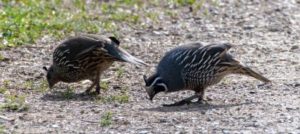

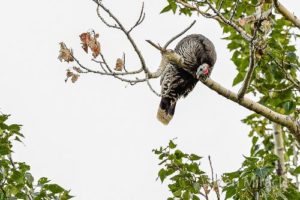
Wading birds
Wading birds are generally large, long-legged birds that wade into fairly deep water. In the Treasure Valley, this group includes herons, egrets, bitterns, and ibises. Herons, egrets, and bitterns have long, straight, dagger-like bills. The ibises have downward curved bills. Of this group, birders in Middleton River Park have seen three species.
Great blue heron – This common wader is the tallest bird in Middleton River Park. Great blue herons nest in colonies in trees, although it’s not certain where the closest colony is located. It’s always weird to see these very large birds in trees where they rest or roost. More commonly, you will see them along the river or in one of the ponds. Although called “blue” the great blue heron is more gray than blue. They have a black plume off the back of the head and the upper side of the flight feathers are black. They typically fly with their necks coiled back and legs straight out behind them with slow wingbeats. Foraging birds typically stand tall and strike very quickly at their prey. When they lean over preparatory to striking, they sometimes wiggle their necks from side to side. Herons eat fish, snakes, lizards, and small mammals so you can also see them in fields, particularly flooded fields or fields that recently have had cattle turned out in them.
Great egret – Great egrets have been mistaken for the white form of the great blue heron and for snowy egrets. The great egret is smaller than a great blue heron and larger than a snowy egret. These birds are all white with a yellow bill and black legs and feet, and long plumes off the tail in breeding. Like the great blue heron, they have long necks which are typically folded back in flight. Great egrets are found in the same locations as great blue herons, also nest in colonies in trees, and have a very similar diet and hunting style.
Black-crowned night-heron – Only one black-crowned night-heron has been spotted in a tree in the marshy area, so we do not know how commonly they may be seen in Middleton River Park. Black-crowned night-herons are the smallest of the three wading birds that have been spotted in the park. They are much stockier than the great blue heron and great egret with a shorter, wider bill and a much larger head in proportion to its body. As one might suspect from their name, they have a black crown as well as a black back and bill, gray body and wings, and yellow legs and feet. Like the other two species, they nest in colonies in trees and fly with their necks folded back. Black-crowned night-herons are most active at night and typically roost in trees near water during the day. Look for them in the larger Russian olives near open water in the marshy area. They have a distinctive call, resulting in some calling them the quak bird.
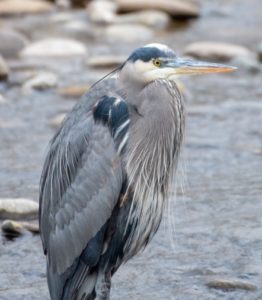
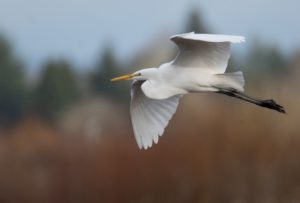
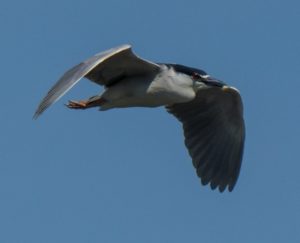
Shorebirds
Shorebirds include several bird families so are quite variable in appearance; some have short legs and some have relatively long legs; some have short bills and some have long bills; bills may be straight, down-curved or up-curved. Shorebirds typically have thin bills and they mostly forage on the shore or in shallow water by picking or probing into mud. Unlike the wading birds, shorebirds have distinctly different breeding and non-breeding plumages.
Black-necked stilt – Stilts are very long-legged, long-necked birds with thin bills that are slightly up-turned. Their legs are pink to red and bodies are black on the upper side and white on the lower side with a white patch above the eyes. Female stilts are browner on the back. Stilts typically occur in small groups and feed in shallow water, picking insects off the surface. Stilts may stop by Middleton River Park and feed around the edges of the ponds but likely do not nest there.
Killdeer – Killdeer are likely present year-round within the Park area and surrounding environs. Within Middleton River Park, look for killdeer in the open areas, along the river and ponds, and in nearby fields. Killdeer are relatively tall and slender for a plover with an unusually long tail and two dark bands across the breast. Juvenile birds have only a single band, that may result in mistaking them for semipalmated plovers. The rump is orange, the back is brown, and the belly is white. Killdeer have a white ring around the throat and white in the face. They prefer to run along the ground. Killdeer are known for their broken wing act to draw attention away from their nests. If you see a killdeer behaving that way, stop. Look around carefully for their nest and eggs. Killdeer do not build a typical nest but create a scrape in gravel or rocks and their mottled eggs blend in very well. Killdeer are “name-sayers” in that their best-known call sounds like kill-DEER kill-DEER kill-DEER.
Least sandpiper – The least sandpiper is our smallest sandpiper. These birds have greenish-yellow legs, generally brown plumage with a brown breast, and a short dark bill that is slightly downturned. In spring, their plumage is typically redder while in fall it is more brownish-gray. Least sandpipers pass through the area during spring and fall migration. Look for them on mudflats and in shallow water on the edges of the smaller ponds. Least sandpipers can be hard to tell from western and semipalmated sandpipers, which also pass through the Treasure Valley during migration, however these other two small sandpipers have black legs and longer bills. In fall, these other two sandpipers are much grayer, with the western sandpiper lighter gray than the semipalmated sandpiper and both lack the more distinct breast coloration of the least sandpiper.
Wilson’s snipe – Migrating Wilson’s snipes likely pass through Middleton River Park in spring and fall and an occasional single bird may winter in the park, but the park area does not have enough of the right habitat to support breeding. Breeding habitat usually consists of taller grasses or sedges and they tend to avoid areas dominated by dense cattails and reeds. Wilson’s snipes are present year-round and breed elsewhere in southern Idaho. Within the park area, look for them on mudflats near tall grassy vegetation or alders and willows, generally near the river. Snipes are medium-sized sandpipers with very long straight bills and a rather chunky body and very short tail. Plumage is generally brown with a boldly striped back and head and heavily barred flanks.
Spotted sandpiper – Spotted sandpipers usually occur singly much of the year or in pairs during breeding along the Boise River. Look for them on rocky bars, islands, and shores. They teeter near constantly, raising and lowering their rear body, which is a good way to know you are looking at a “spotty.” These sandpipers have relatively short legs, a moderately long, straight bill, and brown back and head. In breeding, the breast and flanks are spotted, but in winter they are generally plain white below. Spotted sandpipers are present in spring through fall, migrating out of the area in winter.
Greater yellowlegs – Greater yellowlegs may be seen in shallow water and mudflats along the Boise River or the edges of ponds during spring and fall migration. So far, only single birds have been seen, but small groups may also occur. These are long-legged with a long bill than appears to be slightly upturned. The bill is much longer than the head. The tip of the bill is darker than the base. Overall, the birds are grayish with a speckled look and white bellies. In breeding, adults have dark bars on their flanks. The best clue is their long, bright-yellow legs, although they can wade up to their bellies in water. Their call is a distinctive tuu-tuu-tuu, given rapidly and often descending at the end.
Lesser yellowlegs – Lesser yellowlegs are very similar in appearance to greater yellowlegs and the two can be confused. However, lesser yellowlegs are smaller with a finer, straight bill. The bill is just a bit longer than the head and is less distinctly two-toned than the greater yellowlegs. In breeding plumage, they have fewer bars on their flanks. Lesser yellowlegs also are present only during migration and use the same type of habitat as the greater yellowlegs. Their call is a single or double tuu with the second tuu lower in pitch than the first in a double call.
